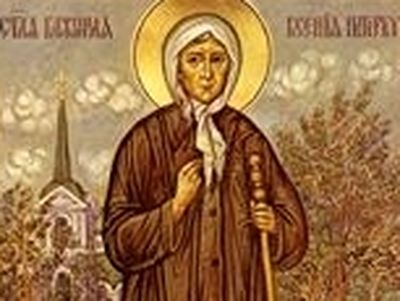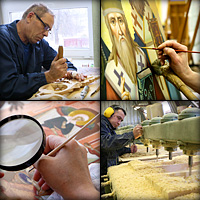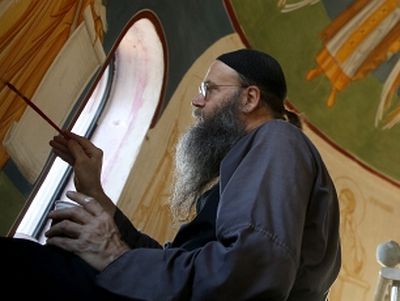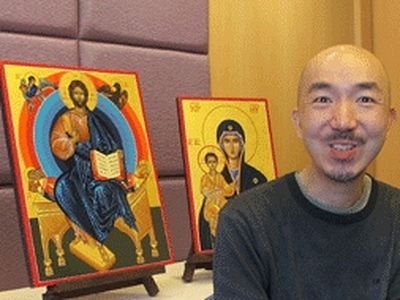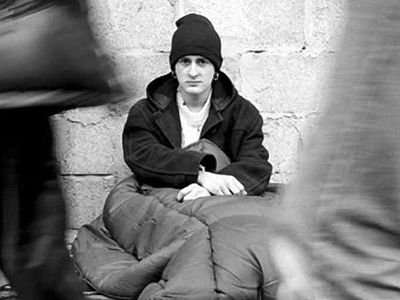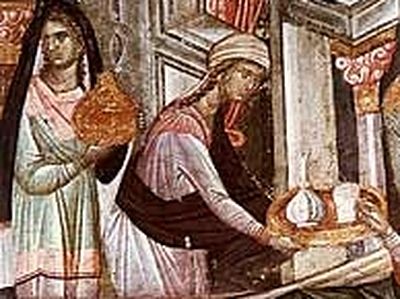Everything came together in Alla Mescherova’s life seemingly as it should: auditing classes in the Repin Academy of Arts in St. Petersburg, then learning iconography in the “School of Ecclesiastical Arts” in Tver—if it hadn’t been for one thing: Alfia (as her parents named her) grew up in a Muslim family, who held the traditions of their ancestors sacred. Nevertheless, her soul found its home in Orthodox Christianity.
—Few Muslims, especially Muslim women, resolve to change their religion against their family’s wishes. What happened to turn the wheel of your family history around so sharply?
—I was born to a Muslim family. Both of my grandmothers were believers and prayed the namaz. My father’s mother was particularly pious—she prayed several times a day according to the Muslim custom, and she taught me the Muslim prayers. Unfortunately the prayers did not touch me because I was repeating them in Arabic, which I did not understand. Grandmother did not know the translation. As I can remember I searched for a conscious faith, and that is why a trusting relationship with God never came together then.
—When did it begin to come together?
—After completing school I continued with determination to search for the meaning of life, beginning with the entire Koran. But I did not find the answers to my questions in that wise book and so began reading various philosophers: Marxists, idealists, and then Soloviev, Berdyaev, and Rozanov. The last of these nudged me toward Christ. But my path to Him would be very thorny: At the end of the 1980s, against the background of a general interest in all things paranormal, certain “abilities” opened up in me and for several years I was stuck in the mire of esotericism, then acquiring a mass of various phobias. In my head then was, in the words of Fr. Andrei Kuryaev, the Russian intelligentsia’s favorite dish—a casserole of Buddhism, esotericism, and theosophy. It was all flavored with an Islamic sauce and peppered with a vague idea of Christianity. It was then that I began to read the Gospels, and I put them under my pillow at night, because only then could I sleep peacefully; without them I was wracked with nightmares. In 1987 my grandmother became sick with cancer and by autumn she was bedridden, worrying above all about how she would most likely die in winter and they would bury her in the cold ground. Then I had a purely coincidental conversation with my teacher while I was sketching on the banks of the Smolenka River, and told him how my grandmother has been near death for over two weeks, and the doctors said she would not live. He offered to take me to Blessed Xenia [of Petersburg], whose chapel was not far away in the Smolensk cemetery, because Xenia helps everyone. When we arrived he showed me where to buy a candle and where to place it. This was at about four o’clock. I prayed from the heart, asking Xenia to help my grandmother and ease her suffering. For some strange reason I had so much trust in an Orthodox saint whom I did not even know that when I came home that evening I wasn’t even surprised to see my grandmother walking around the apartment, and that she had begun to feel better at precisely four o’clock.
—After this you came to Orthodoxy without any doubts?
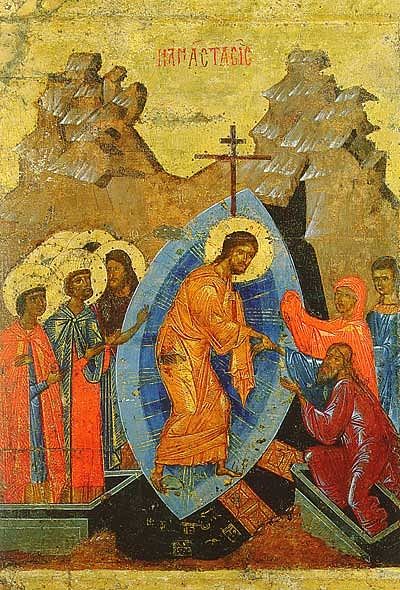 Icon of the Descent into hades
Icon of the Descent into hades
—It wasn’t all so simple. By that time I had read the Gospels and went to church regularly, but I did not have the resolve to be baptized. After all, it is a serious step to change your faith. I understood that this would be a blow to my parents, and I feared for their health. I only asked the Lord to give me a clear and comprehensible sign so that I could understand whether it was His will that I be baptized. And one day I came to church on the Smolenka. There were two hours yet before the beginning of services, not many people present, and I stood in the side church of St. Xenia of Petersburg, leaning on the column. Suddenly the space around me changed—everything disappeared. There was no floor, no ceiling, and nothing at all; however it was not emptiness but a thick dark blueness, almost blackness. It was the black that you see in the mandorla on the Novgorod icon, “Descent into hades.” For a long time I could not understand why the space was dark and only a few years later I read in the writings of Dionysios the Aeropagite that people see Divine uncreated light as darkness. Well, it was insanely beautiful, absolutely incomprehensible, and my feelings were like what a child must feel at his mother’s bosom—protection and love. Then out of the haze enshrouding the entire area a hand stretched toward me holding a cross on a chain. I reached out with the palm of my hand, and when they placed that cross in it, I immediately returned to reality. The next day I went to be baptized without any doubts.
.
—Did iconography come as one of the facets of your profession?
—This was God’s will, and it has its prehistory. In about 1994 a global crisis happened in my life: first of all a creative one—I couldn’t paint pictures; second, the object of my love left me, slamming the door loudly; third, I nearly stopped breathing from asthma. But mainly I understood that this whole bouquet of misfortunes was the result of my former, stormy life. But the Lord never abandons us. Seeing that I could not get through this without God’s church, on February 6, the feast day of Blessed Xenia, I literally crawled to her chapel, stood through the services with great difficulty, and afterwards felt significantly better. When finally I stopped feeling like a half-dead invalid, and began to breathe more or less normally, the question came: How should I live from now on? Should I change my profession at age twenty-nine? But painting was not just a profession for me—for eleven years I had worked like one obsessed sixteen hours a day in order to become a painter. If I were to change professions it would mean that all my labors and sacrifices were in vain and my whole life up to that point was meaningless. Once I had heard about Diveyevo and St. Seraphim of Sarov, and I decided to go to him for the answer to my inner question, although I didn’t have any idea what a monastery was, or a pilgrimage. I went with a friend. We arrived at Nizhny Novgorod without complications but then… Instead of a pleasant three-hour ride in a comfortable bus we stood thirteen hours in a gigantic traffic jam due to a fierce snowstorm. No sooner had this torture on the road ceased than torture from snowdrifts began: For the first (and I hope, last) time in my life I tumbled into snow up to my neck.
I remember the first few days in the monastery like a nightmare. It was very hard. But it was there that I was born again. The woman we stayed with and with whom we formed a friendship within the two weeks we were in Diveyevo asked me one day: “Well, you are an artist. Perhaps you could paint me Blessed Xenia? This request turned out to be absolutely providential. Fr. Vladimir Shishkin came to me personally in the church when he saw my confusion. I explained my situation and he said that he did not bless me to paint an icon “just like that,” that this is something that must be studied, and therefore he blessed me to go to the iconographic work group of Andrei Zaprudny in Tver. He said it and then ran off on his business. I asked him as he ran away, “Batiushka, what about my parents?! After all, they are Muslims, they won’t understand, and won’t let me go to a strange city…” He just waved his hand as he walked and said, “The Lord will take care of it.” Fr. Vladimir turned out to be right: The Lord took care of it so that my parents calmly accepted the news that I was going to study in Tver. True, I didn’t tell them exactly that this was a school of ecclesiastical arts. Having stepped upon the path of Orthodoxy and a new profession, I always felt God’s help and Providence for me.
—Did you ever think of yourself as an iconographer before this? As an artist you probably always admired the works of Theophan the Greek, or Andrei Rublev?
—Before I was even baptized, in probably 1991, I was at an exhibition from the Russian Museum: Kandinsky, Malevich, Goncharev, Chagall, Philonov… But these painting were not what amazed me—although at the time I also loved all of that—but rather the Russian icons from the collection of Nikodim Kondakov, a famous art historian. This was a feast, an untold feeling of paradise and wonder, and I walked around for a long time as if dumbstruck. I returned to this exhibition ten times just for these icons, because Chagall, as it turns out, is not interesting even the third or fourth time around. I was astounded by the mastery with which these icons were painted. I saw paradise on them. And this was a discovery for me, because during Soviet times it was customary to look at Russian icons condescendingly. Now Italian Renaissance, that’s something, but an icon—of course it’s nice, but… This admiration of icons lived in me all the years following and became something like a key that would one day open the door into the world of Orthodoxy. This is what probably determined my present festive style.
—When you started painting saints did temptations arise, or did it all go smoothly and blessedly?
—The first icon I painted was the “Flogging of St. George.” The work group was then painting two iconostases for a Belorussian church, and one altar was dedicated to St. George. Then I painted the Trinity for the iconostasis in Diveyevo. In general there were mostly temptations connected with icon painting. I don’t recall any miracles, but temptations—over the top. Especially when you paint an image to go behind the holy table, a cross, or an iconostasis. I painted my first icon for the altar in the early 2000s for the church of St. Sergius of Radonezh in Sertolov, Vsevolozhskovo region of Leningrad province. I had just barely started my work when I managed to crack my rib. I didn’t think to take painkillers, and the doctors didn’t mention it. The icon board was huge and heavy, and I had to lift it, turn it, take it from the easel, carry it to the table, and then return it again to the easel. Batiushka wanted this icon painted as soon as possible and didn’t consider that I needed sick leave at least for a time after the fracture. Due to constant physical pain I was constantly in a deadened state, and maybe that is why the icon turned out good and prayerful. Everyone said that. The first two icons for my first iconostasis were very hard to do—something was always happening, and then it got a little easier, although it never went smoothly. One of these icons later streamed myrrh. An icon depicts the higher world. We sometimes forget that Christ’s love is behind this phrase. We depict a world of complete, harmonious Love, which cannot be sad, sorrowful, or gloomy—all of that is human. Orthodoxy is the joy of communion with God. That is why we glorify God, for He brought us the good tidings of Love. This is reflected in icons.




